In Quest of those Knights In Shining Armor
By Barbara Thompson
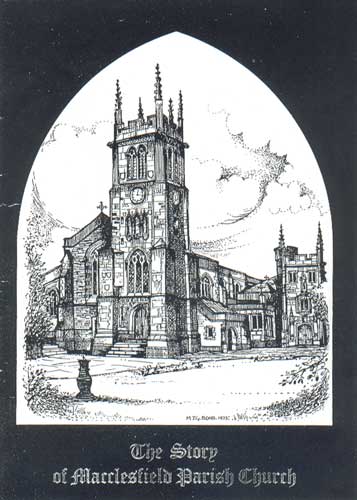
Were those Savages back there In England really knights? And did they really marry into those important families? We decided to find out if everything on the Internet was indeed true. And it was true.
On June 3, 2003 My cousin David Sharpe, companion Dee Dailey and I, Barbara Thompson, flew British Airways non-stop from Sea-Tac Airport In Seattle, Washington to Heathrow In London, England. We had three glorious weeks to find all the information we could seek out. SpendIng the first week in London In beautiful weather we did all the tourist things. David did a great job acting as tour guide. He and Dee had both been to England before so knew what to see and do. We took “The Big Bus” tour, used the underground “tube” to get around London, went to Harrods, The Towers of London, Windsor Castle, Westminster Abbey, The National Gallery, The Crown Jewels, Victoria and Albert Museum, Piccadilly Circus, and of course Soho. I felt a little uncomfortable in Soho when I read a pink notice on a window that turned out to be a planning notice for a sex club England really knows how to take advantage of all us “root seekers”. The red carpet is rolled out and everything is Heritage -Heritage-Heritage We took full advantage. I am not going to write about everything here, just those things pertaining to the Savages.
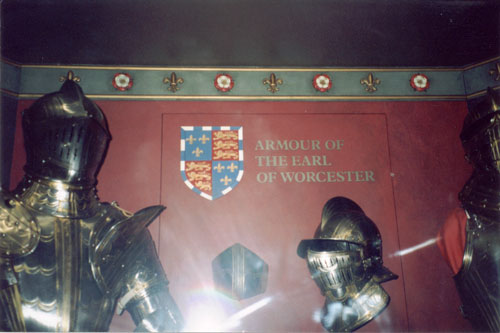
While touring THE TOWER of LONDON we noticed in THE ROYAL ARMOURIES room the battle armour of the Earl of Worcester, William Somerset, a name I recognized in our genealogy. This was the armour of the Third Earl of Worcester, the offspring of our First Earl of Worcester in our family tree. This was an awesome place with all the armour, swords, and battle gear of the Knights of the Garter In medieval days. The cruelest weaponry was of the Spanish, with their thumbscrews and evil looking blades they hurled at their enemies. Their swords looked more like long daggers rather than the flat bladed swords of the English. There was also a wonderful display of life size wooden horses, replicas of those ridden by the Kings and carved head replicas of some of those kings.
 We were fortunate In the time of year we went to England, as Queen Elizabeth had not taken up residency in WINDSOR CASTLE yet. Usually the Royal Family would have returned to London and the castle would have been closed. We were In time to see the changIng of the guard ceremony, complete with the musicians. While touring the castle we had a chance to see the Queen Mum’s doll house. Then we were looking at the shields of The Knights of the Garter in St. George’s Chapel when I noticed one with Sir John Savage’s name next to it. We were told to look at the number next to it and it would correspond with a shield on the wall or ceiling. But the shield was not the shield with the six lions rampant of the Savages. Then came the realization that the Savages really had more than one shield. This shield was prior to the shield adopted by the Savages at a later date of six lions rampant. We did not have time to look at all of the shields. There might have been others. Looking further I noticed the name of Sir Darcy.
We were fortunate In the time of year we went to England, as Queen Elizabeth had not taken up residency in WINDSOR CASTLE yet. Usually the Royal Family would have returned to London and the castle would have been closed. We were In time to see the changIng of the guard ceremony, complete with the musicians. While touring the castle we had a chance to see the Queen Mum’s doll house. Then we were looking at the shields of The Knights of the Garter in St. George’s Chapel when I noticed one with Sir John Savage’s name next to it. We were told to look at the number next to it and it would correspond with a shield on the wall or ceiling. But the shield was not the shield with the six lions rampant of the Savages. Then came the realization that the Savages really had more than one shield. This shield was prior to the shield adopted by the Savages at a later date of six lions rampant. We did not have time to look at all of the shields. There might have been others. Looking further I noticed the name of Sir Darcy. 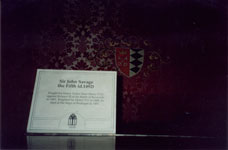 One of our Sir John Savages married his daughter. His shield was vacant. We were told by a very snooty guard that meant he was disgraced, probably beheaded or drawn and quartered for treason or some such thing. Smirk, smirk. He was probably tired of all those Americans looking for some bit of glamour in their dull genealogy. Being drawn and quartered meant beIng hung until almost dead, taken down, lain out on a table while still alive, slit across the belly, then
down the belly, and the guts removed, then the heart. A cruel people. Supposedly a Savage was drawn and quartered so inhumanly that the practice was no longer done by the English. In the gift shop, and there was always a gift shop, I found key chains with different shields and the knight’s coat of arms on them. There were the Savages, with six lions rampant!!! So I bought all that were left. One of our Sir John Savages married his daughter. His shield was vacant. We were told by a very snooty guard that meant he was disgraced, probably beheaded or drawn and quartered for treason or some such thing. Smirk, smirk. He was probably tired of all those Americans looking for some bit of glamour in their dull genealogy. Being drawn and quartered meant beIng hung until almost dead, taken down, lain out on a table while still alive, slit across the belly, then
down the belly, and the guts removed, then the heart. A cruel people. Supposedly a Savage was drawn and quartered so inhumanly that the practice was no longer done by the English. In the gift shop, and there was always a gift shop, I found key chains with different shields and the knight’s coat of arms on them. There were the Savages, with six lions rampant!!! So I bought all that were left.
It seemed everyone on” The Tube” was sneezIng and of course we all got sick, one at a time. First was Dee. While she recuperated David and I went to Trafalgar Square to see the statue of David’s great granddaddy, Lord Horatio Nelson, who saved England single handedly. David’s granddaddy married Lord Nelson’s daughter and I think everyone in England now knows it !!!!
Nothing had prepared me for the glorious sight of WESTMINSTER ABBEY. What a feast for your eyes. I was shocked at all the tombs with all the effigies on top. Here were tombs of kings and queens and heroes from medieval days forward. All with the effigies on top. Where did all that artistic ability come from? Anything I wrote here could not begin to say what this awesome old church is like. This medieval church dates back to at least 1065. We spent about 4 hours there. I noticed a plaque on the wall of one of the chambers with the name of Jannis Savage. I don’t read Latin too well so decided to ask. But, alas we could not find it again, so we will never know what it said. One of the guides did say it was indeed John Savage, tho. So now we have Savages in Windsor Castle and Westminster Abbey.
So now our journey takes us to MACCLESFIELD, ENGLAND In the interior of the country. We rented a car for this part of the trip. It took David a few days to master the narrow streets and driving on the wrong side of the road. It was kind of like breaking a buckIng bronco, once mastered the car behaved. I had made arrangements over the internet for a B&B in Macclesfield and we had wonderful food and lodging, with a full English breakfast, tea, coffee, orange juice, toast, eggs, bacon, blood sausage, white sausage, cereal, fruit, and baked beans. All for 25 pounds a night. Of course we did not eat all that ! ! ! !Very Inexpensive in comparison to our motels and continental breakfast. Macclesfield is a beautiful medieval town with narrow cobblestone streets. One wonders why the Savages ever left there. I don’t think there was any more for them to conquer in England so they came to America, 13 years before the Mayflower to conquer America. Dee and I went to the Visitors Center where we bought a book with some history of the Savages in the Macclesfield area in it. Bought more souvenirs. And got the names of two tour guides to take us around. I spent the afternoon at the library with the microfiche goIng over old parish records. But as luck would have it almost all of the film was so old it was undecipherable. A complete waste of time.
Next day, with David driving we headed for CHESTER and the RECORDS OFFICE. I had made arrangements over the internet (what would we do without the internet?) to reserve microfiches and Savage records. While Dee toured the walled City of Chester, David and I looked at books and film. We found a book, “The History of Cheshire” that reads like the Savage history. We copied off the Savage part, not realizing that the Savages had married daughters of the other families written up In the book, and Savage daughters had married the sons. It was then that I realized that the Savages were SOMEBODY in England. There were historians at the records office sitting sippIng their coffee who had ‘done the Savages’. We had Interesting conversations with them. But they
weren’t telling what they found out !!!!
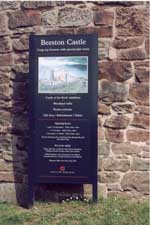 The next day found us with our hired tour guide. We had given her a list of places we wanted to check out but not much was left of our historical Savage sites. Remember, this history in from 1066 to the 1800’s. The first place she took us was BEESTON CASTLE, outside Chester. This castle came Into the family thru marriage. Did I tell you the Savages married well? Our old castle has been partially restored and is now a tourist attraction1 Complete with jousting tournaments on weekends. England is big on medieval pageantry and the government has taken over some of the castles, partially restorIng them, leaving some of the old stonework, and using them for tourist attractions. The records show some Savages are buried at Beeston Castle. One of the sales girls said there was a cemetery on the hill inside the castle but was so overgrown with blackberries you cant get near it. Most of the castle walls are still in good enough shape that you can well imagine what the complete castle used to look like. And the view is a real estate agent’s dream. . . These castles were built on hills so invading enemies had a hard time tackling the walls, having boiling oil poured down on them, etc. . After buying more souvenirs, our tour guide, Silvia Roberts, showed us where ROCKSAVAGE, the famous castle of the Savages, once stood. Nothing left but the bluff it once sat on. We were greatly disappointed. We thought we might find headstones of Savages in one of the old church yards in the Clifton area but they were so defaced by the ravages of time, wind, and weather they were unreadable. I was getting a little discouraged, but the next day certainly made up for that.
The next day found us with our hired tour guide. We had given her a list of places we wanted to check out but not much was left of our historical Savage sites. Remember, this history in from 1066 to the 1800’s. The first place she took us was BEESTON CASTLE, outside Chester. This castle came Into the family thru marriage. Did I tell you the Savages married well? Our old castle has been partially restored and is now a tourist attraction1 Complete with jousting tournaments on weekends. England is big on medieval pageantry and the government has taken over some of the castles, partially restorIng them, leaving some of the old stonework, and using them for tourist attractions. The records show some Savages are buried at Beeston Castle. One of the sales girls said there was a cemetery on the hill inside the castle but was so overgrown with blackberries you cant get near it. Most of the castle walls are still in good enough shape that you can well imagine what the complete castle used to look like. And the view is a real estate agent’s dream. . . These castles were built on hills so invading enemies had a hard time tackling the walls, having boiling oil poured down on them, etc. . After buying more souvenirs, our tour guide, Silvia Roberts, showed us where ROCKSAVAGE, the famous castle of the Savages, once stood. Nothing left but the bluff it once sat on. We were greatly disappointed. We thought we might find headstones of Savages in one of the old church yards in the Clifton area but they were so defaced by the ravages of time, wind, and weather they were unreadable. I was getting a little discouraged, but the next day certainly made up for that.
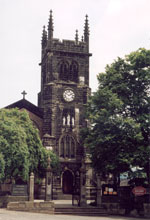 Our B&B Moorhayes House, in Macclesfield was within walking distance of our destination for the day so we set out to find ST. MICHAEL’S CHURCH and SAVAGE CHAPEL. After the disappointments of the day before we were delighted to find the church located at the end of a cobblestone street overlooking the valley. It was easy to see why this sight was chosen by the maraudIng Normans. Located high on the hill overlooking the forests and valleys it had a great vantage point in times of battle, a strong defensive position surrounded by low lying country on three sides and a river on the fourth. It is here that the Savages probably first lived after entering England in 1066 with William the Conqueror.
Our B&B Moorhayes House, in Macclesfield was within walking distance of our destination for the day so we set out to find ST. MICHAEL’S CHURCH and SAVAGE CHAPEL. After the disappointments of the day before we were delighted to find the church located at the end of a cobblestone street overlooking the valley. It was easy to see why this sight was chosen by the maraudIng Normans. Located high on the hill overlooking the forests and valleys it had a great vantage point in times of battle, a strong defensive position surrounded by low lying country on three sides and a river on the fourth. It is here that the Savages probably first lived after entering England in 1066 with William the Conqueror.
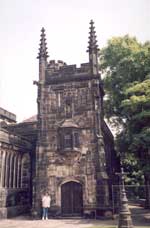 The church is called THE CHURCH IN THE MARKET PLACE . The church and Savage Chapel are not only used for weekly services but also are the primary tourist attraction in Macclesfield. St. Micheal’s church is quite a large building of dark square stones with tall medieval spires. It was thought that the church was built after 1066, when the Normans invaded England. Attached on the right of the church is the Savage Chapel, a three storied tower and priest rooms. It is also built of dark stone and has the same medieval look with tall spires. There is also the Legh Chapel in the church, built in 1442, followed by the Savage Chapel. It is thought the Savage Chapel was built around 1504 by the Archbishop of York, Thomas Savage, whose heart is placed in the walls of the chapel. I think the chapel stood before that time as there are tombs of Savages~in the 1490’s. Parish registers were not started until 1572 so no records exist before that time. We do know there are Savages buried under the chapel. I am not goIng into Savage genealogy here, though.
The church is called THE CHURCH IN THE MARKET PLACE . The church and Savage Chapel are not only used for weekly services but also are the primary tourist attraction in Macclesfield. St. Micheal’s church is quite a large building of dark square stones with tall medieval spires. It was thought that the church was built after 1066, when the Normans invaded England. Attached on the right of the church is the Savage Chapel, a three storied tower and priest rooms. It is also built of dark stone and has the same medieval look with tall spires. There is also the Legh Chapel in the church, built in 1442, followed by the Savage Chapel. It is thought the Savage Chapel was built around 1504 by the Archbishop of York, Thomas Savage, whose heart is placed in the walls of the chapel. I think the chapel stood before that time as there are tombs of Savages~in the 1490’s. Parish registers were not started until 1572 so no records exist before that time. We do know there are Savages buried under the chapel. I am not goIng into Savage genealogy here, though.
During the Civil War, Cromwell’s Invaders twice attacked the church and the steeple and roof of the church were blown off. The church sustained considerable damage but with the Savage Chapel only sustaining damage to it’s roof.. Wind and weather did more damage. In 1740 the ancient church was rebuilt. Again, we were fortunate that we went to England when we did. This church was closed down for extensive renovations the very next weekend after services. We would not have been able to see the glorious sights of our forefathers in effigy had we not made the trip when we did. We Savages owe a debt of gratitude to the people of Macclesfield and St Michael’s Church for preserving the Savage and Legh Chapels. They also have done a great job of restoring and preservIng the tombs and effigies of the Savages and Leghs. I guess I should say here that two of the Savage daughters married Legh sons, hence the Savage-Legh connection. In fact the Savages were connected to almost every family in Cheshire through marriage, even the de’Macclesfield’s.
Entering the church you are hit by the dark and gloomy atmosphere , what you can expect from a church at least 900 years old. After your eyes adjusted to the gloom the church turned out to be warm and inviting. The Interior was striking with arches crowned with a clerestory.
We were greeted warmly by the ladies of the church, also a lady interested in heraldry that had come to meet with us. This lady was gave us material she had gleaned from her studies about the heraldry of the Savages. Looking toward the chancel we saw tombs on both sides. To the right was the tomb of Sir John Savage and his wife Lady Katherine,
daughter of Sir Thomas Stanley, knight, and sister of the first Earl of Derby. The alabaster effigies are beautiful examples of fifleen century craftsmanship. Sir John is clad in armour plate, his right hand clasping that of Katherine. They were the parents of Thomas, Bishop of Rochester, London, and later Archbishop of York who is credited with buildIng the Savage Chapel.
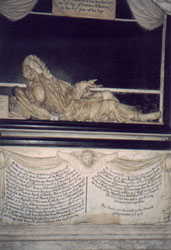 But the most prominent of these monuments is that of Right Hon. Thomas Savage, Earl Rivers Viscount Colchester, Baron Darcy of Chich, and Savage of Rocksavage, etc ,etc. Thomas died In 14 September 1694 at age 67, pretty old for that century. This splendid English Baroque style monument shows Thomas in a wig with flowing draperies caught behind looped curtains, framed by huge alabaster pillars and pediment. This alabaster monument is the signed work of the famous Stuart sculptor, William Stanton, and is regarded as being one of his finest works. He was also married to a Savage daughter. At the top of this huge monument is depicted nine shields given to or inherited by Thomas Savage. At the corners of the pillars are two shields with the Savage sheilds. David and I had to have our pictures taken by this beautiful piece of art. It was a little awesome to realize his well preserved body was just under it. In those days they were buried in lead tombs and the bodies were well preserved.
There were also a tomb and effigies of Sir John Savage, Knight of the Garter. He commanded the left wing at the Battle of Bosworth in 1485 and was killed at the siege of Boulogne in 1492.
But the most prominent of these monuments is that of Right Hon. Thomas Savage, Earl Rivers Viscount Colchester, Baron Darcy of Chich, and Savage of Rocksavage, etc ,etc. Thomas died In 14 September 1694 at age 67, pretty old for that century. This splendid English Baroque style monument shows Thomas in a wig with flowing draperies caught behind looped curtains, framed by huge alabaster pillars and pediment. This alabaster monument is the signed work of the famous Stuart sculptor, William Stanton, and is regarded as being one of his finest works. He was also married to a Savage daughter. At the top of this huge monument is depicted nine shields given to or inherited by Thomas Savage. At the corners of the pillars are two shields with the Savage sheilds. David and I had to have our pictures taken by this beautiful piece of art. It was a little awesome to realize his well preserved body was just under it. In those days they were buried in lead tombs and the bodies were well preserved.
There were also a tomb and effigies of Sir John Savage, Knight of the Garter. He commanded the left wing at the Battle of Bosworth in 1485 and was killed at the siege of Boulogne in 1492.
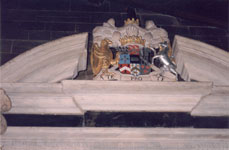

Then there was a tomb with the effigies of Sir John Savage and his wife Lady Elizabeth, daughter of Charles Somerset, Earl of Worcester. (Remember the armour in the Towers?) His effigies shows him in full armour.
Then there was the tomb and effigy of Sir John Savage, in plate armour. He was son of the Sir John that died in battle at Boulogne This was another splendid monument. The church ladies keep the sculptures well dusted and polished. I’m not so sure the placards get placed back on the proper effigies when done, tho.
In the center of the wall is a canopied monument of Sir John Savage and his wife, Lady Elizabeth, daughter of Thomas Manners, 1st Earl of Rutland. On the other side of this monument is a white alabaster tomb thought to be George Savage, Chancellor of the Diocese of Chester. With all of the Sir Johns and Sir Thomas’s in this family--please don’t name your kid John or Thomas !!!!!!
The smaller Legh Chapel is now used as a baptistry. It was to this chapel that they brought the body of Sir Piers Legh of Lyme, a staunch supporter of Richard II. He was beheaded on the orders of Henry of Bolingbroke at Chester.
About this time David caught Dee’s cold and was feeling pretty punk. We came back to St. Michael’s the next evening for Even Song service. It felt rather wonderful to sit in this 900+ year old church with your medieval relations all around and worship in this century’s old Anglican church in a different country so many miles from Birdsview, Washington. LeavIng the church we decided to walk down the famous 108 steps at the back of the Savage Chapel. You could almost hear the thundering hooves of the horses and riders coming up those stairs and out onto the cobblestone streets.
One note about the food in England---It was awful. . . . We didn’t eat in the plush restaurants in downtown London, but we picked nice restaurants and the food was still awful. We even resorted to KFC bad that was just as bad. Then we remembered what
everyone back home said. . . Eat in the PUBS.. We did and the food was great, so was the Guinness.
The next morning we said goodbye to Macclesfield and England. What a feast for our genealogy eyes we had In this quaInt city. We took the Stena LIne fast boat from HOLYHEAD, ENGLAND across the Irish Sea to DON LAOGHAIRE, IRELAND. It was Monday 16 June and I felt miserable. I was coming down with the London subway crud. I dislike public transportation for that very reason. David and Dee were getting better.
In Northern Ireland David searched records at the Heritage Center in TYRONE where he had contacted a genealogist for Sharpe genealogy and David drew a blank there. They could find no name of Sharpe. That evening at our B&B David opened up the telephone book and there was a page of Sharpes.
The B&B host suggested we talk to a J.C. Savage, the owner of a grocery store just down the street so we walked over to talk to him. He said Ireland was filled with Savages. They had been Anglican but married Catholic girls and took their religion. They had large family’s. J.C had nine kids, three In the grocery business. He said they came to Ireland in Norman times In 1084 with De Coursey and never left. He said the Irish Savages descended from ‘the black Savages’. So we said goodbye to our newfound Savage In Ireland.
We decided to tour the BUSHMILLS DISTILLARY. After the tour David was one of those chosen to taste the whiskey. While I was sitting at a table sipping a hot toddy, a cute little woman asked if she could sit at the table. Of course I said ‘yes’. She asked what we were doing in Ireland and I told her ‘looking up Savage family history’. She said’ Well, I am a Savage, too. But I come from the Macclesfield branch so we aren’t related’ She was from AUSTRALIA !!! And here we met a cousin In the distillery in Ireland, she from Australia and we from the United States. Coincidence??
We also drove to the AMERICAN HERITAGE CENTER where David had a nice librarian run off some Irish Savage history for us.. While driving thru Northern Ireland we noticed armed soldiers lining the streets. We somehow got caught up In the middle of their convoy. Next day we learned there had been a bomb found that had not gone off. After seeIng the armed guards at the American Council ate in London, and now armed soldiers in Ireland I wondered I wondered if we also had armed guards around Washington D.C.. After almost two weeks In Ireland doing all the tourist things and looking for Savages and Sharpes we were ready to board the Air Lingus plane for London and then British Air for home. We had come 4800 miles and we had gathered all the information we felt we could and had a great time doing it.
|